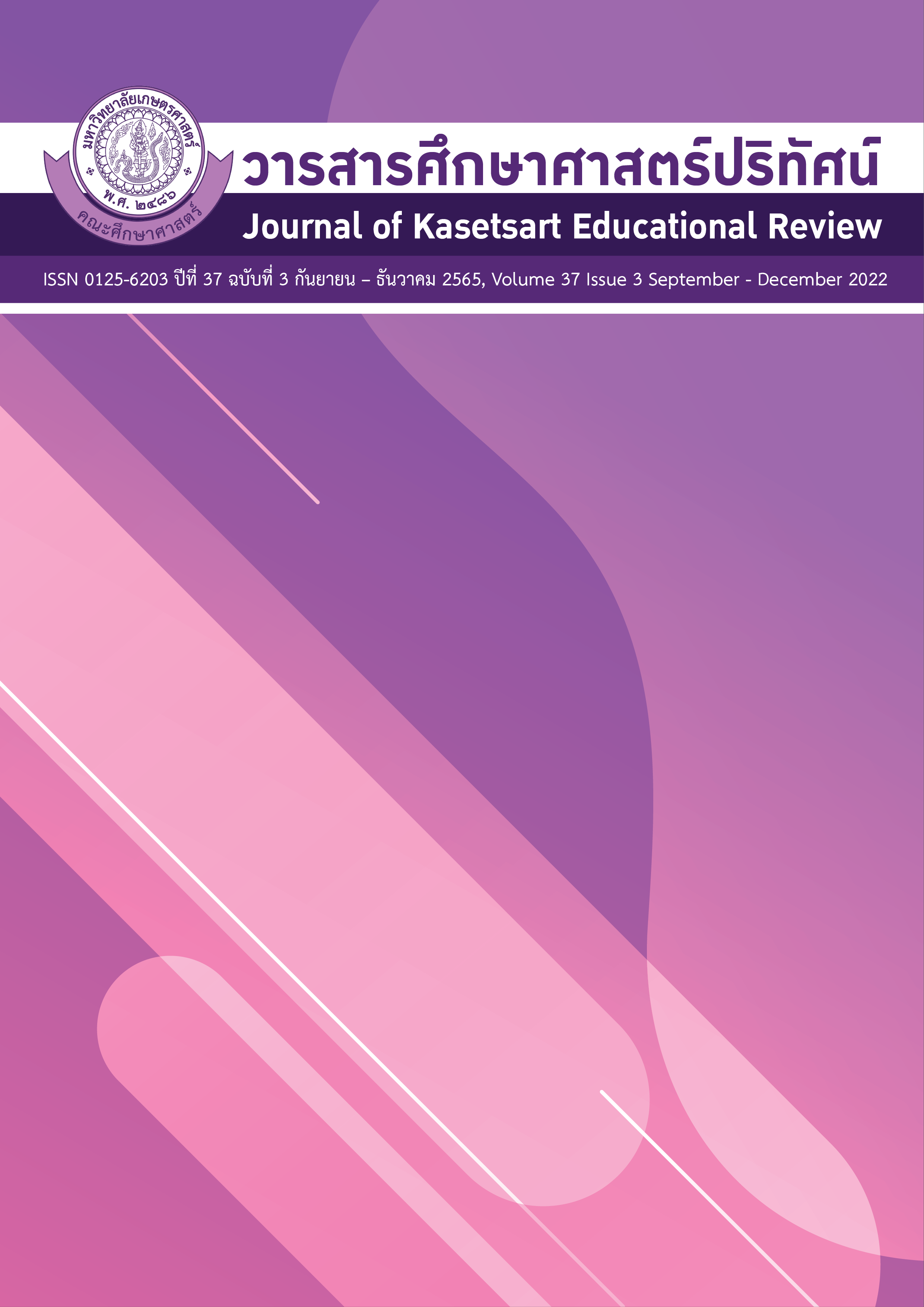ผลการจัดการเรียนรู้แบบเปรียบเทียบ เรื่อง พันธะเคมี ที่มีต่อมโนมติทางวิทยาศาสตร์และการเสนอตัวแทนความคิด ของนักเรียนระดับชั้นมัธยมศึกษาปีที่ 4 โรงเรียนลองวิทยา จังหวัดแพร่
คำสำคัญ:
การจัดการเรียนรู้แบบเปรียบเทียบ, ความเข้าใจมโนมติทางวิทยาศาสตร์, การเสนอตัวแทนความคิด, พันธะเคมีบทคัดย่อ
การวิจัยครั้งนี้มีวัตถุประสงค์เพื่อ 1) เปรียบเทียบความเข้าใจมโนมติทางวิทยาศาสตร์เรื่อง พันธะเคมี ของนักเรียนหลังเรียนระหว่างกลุ่มที่ได้รับการจัดการเรียนรู้แบบเปรียบเทียบและแบบปกติ 2) เปรียบเทียบการเสนอตัวแทนความคิดเรื่อง พันธะเคมี ของนักเรียนหลังเรียนระหว่างกลุ่มที่ได้รับการจัดการเรียนรู้แบบเปรียบเทียบและแบบปกติ 3) เปรียบเทียบความเข้าใจมโนมติทางวิทยาศาสตร์เรื่อง พันธะเคมี ของนักเรียนระหว่างก่อนเรียนและหลังเรียนของนักเรียนที่ได้รับการจัดการเรียนรู้แบบเปรียบเทียบ และ 4) เปรียบเทียบการเสนอตัวแทนความคิดเรื่อง พันธะเคมี ของนักเรียนระหว่างก่อนเรียนและหลังเรียนของนักเรียนที่ได้รับการจัดการเรียนรู้แบบเปรียบเทียบ กลุ่มตัวอย่างที่ใช้ในการวิจัย ได้แก่ นักเรียนชั้นมัธยมศึกษาปีที่ 4 โรงเรียนลองวิทยา 2 ห้องเรียน จำนวน 53 คนได้มาโดยการสุ่มแบบกลุ่ม แล้วจับฉลากให้ห้องหนึ่งเป็นกลุ่มทดลอง จำนวน 29 คน อีกห้องหนึ่งเป็นกลุ่มควบคุม จำนวน 24 คน เครื่องมือที่ใช้ในการวิจัย ได้แก่ 1) แผนการจัดการเรียนรู้แบบเปรียบเทียบ 2) แผนการจัดการเรียนรู้แบบปกติ และ 3) แบบวัดมโนมติทางวิทยาศาสตร์และตัวแทนความคิด วิเคราะห์ข้อมูลโดยใช้ร้อยละ ค่าเฉลี่ย ส่วนเบี่ยงเบนมาตรฐาน และ
การวิเคราะห์ความแปรปรวนร่วม
ผลการวิจัยพบว่า 1) นักเรียนกลุ่มทดลองมีความเข้าใจมโนมติทางวิทยาศาสตร์หลังเรียนสูงกว่านักเรียนกลุ่มควบคุมอย่างมีนัยสำคัญทางสถิติที่ระดับ .01 2) นักเรียนกลุ่มทดลองมีการเสนอตัวแทนความคิดหลังเรียนสูงกว่านักเรียนกลุ่มควบคุมอย่างมีนัยสำคัญทางสถิติที่ระดับ .01 3) ความเข้าใจมโนมติทางวิทยาศาสตร์หลังเรียนของนักเรียนกลุ่มทดลองมีระดับสูงกว่าก่อนเรียน 4) การเสนอตัวแทนความคิดหลังเรียนของนักเรียนกลุ่มทดลองมีระดับสูงกว่าก่อนเรียน
เอกสารอ้างอิง
Boonkong, F. (2015). The Effects of Learning Activities Management Using the Analogy Approach of Learning Management in the Topic of Rates of Chemical Reactions on Scientific Concepts and Scientific Reasoning of Mathayom Suksa V Students at Lam -Phraphloeng Pitthayakhom School in Nakhon Ratchasima Province. Master of Education Thesis, Sukhothai Thammathirat Open University. [in Thai]
Çalik, M., Ayas, A., & Coll, R. K. (2009). Investigating the effectiveness of analogy activity in improving students’ conceptual change for solution chemistry concepts. International Journal of Science and Mathematics Education, 7, 651 - 676.
Cetin, P.S., Kaya, E. & Geban, O. (2009). Facilitating conceptual change in gases concepts. Journal Science Education technology, 18, 130 - 137.
Chaowakeratipong, N. (2014). Science Teaching Management. Nonthaburi: Department of Education, Sukhothai Thammathirat Open University. [in Thai]
Faikhamta, C. (2017). Media used in the teaching of chemistry. Nonthaburi: Department of Education, Sukhothai Thammathirat Open University. [in Thai]
Faikhamta, C. (2020). Chemistry learning management strategies. Bangkok: Chulalongkorn University. [in Thai]
Gafoor, K. A., & Shilna, V. (2013). Analogies: A Method to Facilitate Chemistry Learning In Schools. Journal of Educational Technology and Research. Retrieve from https://www.researchgate.net/publication/262924156.
Harrison, A.G. & Treagust, D.F. (2006). Teaching and learning with analogies. Metaphor and analogy in science education. 30, 11-24.
Jaber, L.Z. & Boujaoude S. (2011). A Macro-Micro-Symbolic Teaching to Promote Relational Understanding of Chemical Reactions. International Journal of Science Education, 34(7), 973-998.
Jitseng, B., Thammaprateep, J. & Chaowakeeratipong, N. (2018). The Effects of Problem Based Learning in the Topic of Chemistry of Life on Learning Achievement and Analytical Thinking Ability of Matthayom Suksa IV Students at Princess Chulabhorn’s College, Satun in Satun Province. STOU education journal. 11(2), 142-154. [in Thai]
Kaewkram, S. (2020). 10 chemical innovations changed the world. Journal of the Department of Science Service. Retrieved from http://siweb1.dss.go.th/ dss_doc/dss_doc/show_discription_doc.asp?ID=2230. [in Thai]
Kozma, R., & Russell, J. (2005). Students becoming chemists: Developing representational competence. Visualization in science education. London: Kluwer. 1, 125-130.
Ninlakhot, S. (2012). A Study of Grade 10 Students’ Covalent Bonding Concept Teaching With Analogy. Master of Education Thesis. Khon Kaen University. [in Thai]
Office of the National Economic and Social Development. (2016). Economic and Social Development Plan National for 12th. Retrieved from https://www.nesdc.go.th/main.php?filename=index. [in Thai]
Phenglengdi, B. (2019). Teaching and Learning Chemistry by Applying Three Levels of Thinking. Kasetsart Educational Review. 33(2), 145-157. [in Thai]
Sangkakram, S. (2010). Grade 10 Students’ Mental Models of Chemical Bonding by Using Analogy Teaching Approach: Focus-Action-Reflect (FAR) Guide. Master of Education Thesis. Khon Kaen University. [in Thai]
Srikunha, A. (2014). The Study on Conception and Representionin Ionic Bond of Grade 10 Students’ Using Conceptual Change Approach. Master of Education Thesis. Khon Kaen University. [in Thai]
Taber, K.S. (2011). Effect of animation enhanced conceptual change texts on 6th grade students’ understanding of the particulate nature of matter and transformation during phase changes. Computers & Education. 57, 1114–1126.
Treagust, D.F. & Venville, G. J. (1996). The role of analogies in promoting conceptual change in biology. Instructional Sci. 24(4), 295-320.
Treagust, D.F. Harrison, A.G. & Venville, G.J. (1998). Teaching Science Effectively With Analogies: An Approach for Preservice and Inservice Teacher Education. Journal of Science Teacher Education, 9(2), 85-101.
Wichaidit, P.R. (2018). Management of Chemistry for 21st Century Learners. Bangkok: Thammasat University. [in Thai]
ดาวน์โหลด
เผยแพร่แล้ว
ฉบับ
ประเภทบทความ
สัญญาอนุญาต
ลิขสิทธิ์ (c) 2022 วารสารศึกษาศาสตร์ปริทัศน์

อนุญาตภายใต้เงื่อนไข Creative Commons Attribution-NonCommercial-NoDerivatives 4.0 International License.
บทความทุกบทความเป็นลิขสิทธิ์ของวารสารคณะศึกษาศาสตร์ มหาวิทยาลัยเกษตรศาสตร์ วิทยาเขตบางเขน
วารสารศึกษาศาสตร์ปริทัศน์ (Kasetsart Educational Review)






